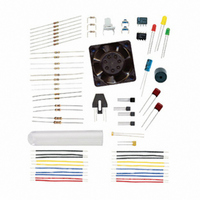130-28176 Parallax Inc, 130-28176 Datasheet - Page 255

130-28176
Manufacturer Part Number
130-28176
Description
KIT PARTS PROCESS CONTROL
Manufacturer
Parallax Inc
Specifications of 130-28176
Accessory Type
Education Kit
Product
Microcontroller Accessories
Lead Free Status / RoHS Status
Contains lead / RoHS non-compliant
For Use With/related Products
Board of Education Full Kit
Lead Free Status / RoHS Status
Lead free / RoHS Compliant, Contains lead / RoHS non-compliant
- Current page: 255 of 330
- Download datasheet (11Mb)
Chapter 8: Proportional-Integral-Derivative
Control
PID is an acronym for Proportional-Integral-Derivative Control. In this chapter, we will
explore each of these control methods and how they work together to efficiently control a
system.
One objective of a process control method is to hold a system constant. In the previous
chapter we used various means of cycling the heater of our incubator to maintain a
desired temperature. Using differential gap, we created an allowable band, or range of
temperatures, in which the heater would cycle, causing the temperature to cycle on and
off, above and below the desired setpoint. In Chapter 6, we saw how we could use pulse-
width modulation (PWM) to add variable amounts of energy to our system in duty cycles
between 0% (fully off) and 100% (fully on). While these types of control have their
advantages and disadvantages, PID control allows greater control of a system but can be
more difficult to implement and tune (or adjust) for optimum performance. Holding a
process constant involves continually adding energy that exactly equals the system
energy losses. If the system losses were constant, then process control would be as simple
as applying one steady state level of drive. However, the factors that affect a process do
change. They change in unpredictable magnitudes and at unpredictable rates.
Compounding this problem is that a system has reaction delays that must be understood.
An instant change in energy losses due to a disturbance is not felt immediately.
Furthermore, an instant change in drive does not create an instant output response.
Process control can be as much an art form as it is a science. The first step to
understanding PID control is to realize that every system has both gains and losses of
energy.
A system is said to be in equilibrium when the energy gained equals the energy lost.
In equilibrium, our incubator would maintain a constant temperature. But this is seldom,
if ever, the case. Depending on the heater drive and conditions surrounding the incubator,
temperature will either be increasing or decreasing. Conditions of the system will change
the energy loss, such as room temperature changing, air movement changes around the
E
Equilibrium: E
System
= E
In
− E
In
Out
= E
Out
Related parts for 130-28176
Image
Part Number
Description
Manufacturer
Datasheet
Request
R

Part Number:
Description:
KIT PROPELLER EDU PROJECT PARTS
Manufacturer:
Parallax Inc
Datasheet:

Part Number:
Description:
KIT PARTS SMART SENSORS
Manufacturer:
Parallax Inc
Datasheet:

Part Number:
Description:
Microcontroller Modules & Accessories DISCONTINUED BY PARALLAX
Manufacturer:
Parallax Inc

Part Number:
Description:
BOOK UNDERSTANDING SIGNALS
Manufacturer:
Parallax Inc
Datasheet:

Part Number:
Description:
COMPETITION RING FOR SUMOBOT
Manufacturer:
Parallax Inc
Datasheet:

Part Number:
Description:
TEXT INFRARED REMOTE FOR BOE-BOT
Manufacturer:
Parallax Inc
Datasheet:

Part Number:
Description:
Microcontroller Modules & Accessories DISCONTINUED BY PARALLAX
Manufacturer:
Parallax Inc

Part Number:
Description:
BOOK UNDERSTANDING SIGNALS
Manufacturer:
Parallax Inc
Datasheet:

Part Number:
Description:
BOARD EXPERIMENT+LCD NX-1000
Manufacturer:
Parallax Inc
Datasheet:

Part Number:
Description:
IC MCU 2K FLASH 50MHZ SO-18
Manufacturer:
Parallax Inc
Datasheet:













